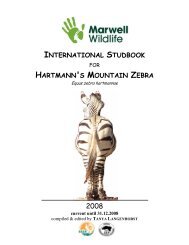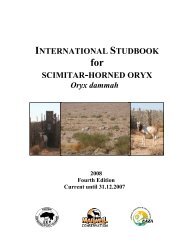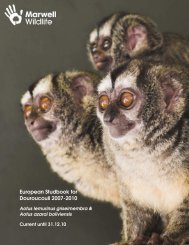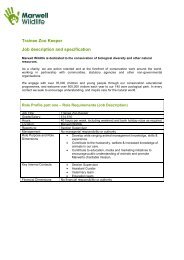Adaptation Trail - Marwell Wildlife
Adaptation Trail - Marwell Wildlife
Adaptation Trail - Marwell Wildlife
You also want an ePaper? Increase the reach of your titles
YUMPU automatically turns print PDFs into web optimized ePapers that Google loves.
7. Ocelot<br />
Habitat: Forests, scrubland and savanna<br />
Similarities to a soldier: Waterproof coat; Camouflaged (Found on information board)<br />
How these similarities help ocelot to survive in its habitat: Oily coat to waterproof it in wet<br />
rainforest; Uses colours and patterns on its coat to camouflage it to help it hide from its prey<br />
8. Ring-tailed coati<br />
Habitat: Forests and woods<br />
<strong>Adaptation</strong>s: Strong short legs and claws to help it climb; Narrow nose to search for food; Thick fur to<br />
keep it warm; Long tail to help it balance<br />
Special feature: They can turn their ankles 180° (Found on information board)<br />
9. Bactrian camel<br />
Habitat: Semi-arid to arid plains, grasslands and desert<br />
<strong>Adaptation</strong>s: Wide feet to spread out weight and stop camel sinking in the sand; Hump to store fat<br />
when food and water is scarce; Long eyelashes to keep sand out of eyes; Sandy coloured for<br />
camouflage<br />
10. Bat-eared fox<br />
Habitat: Savanna, plains, grassland and steppes<br />
1. Zebras eat grass<br />
2. Zebras poo<br />
3. Dung beetles roll<br />
up the poo<br />
4. Dung beetles lay<br />
their eggs into the poo<br />
5. Eggs hatch into<br />
larvae<br />
6. The larvae eat the<br />
zebra poo<br />
7. Bat-eared foxes<br />
love to eat dung<br />
beetle larvae<br />
Why do bat-eared foxes follow zebras? Where there are zebras there is fox food!<br />
<strong>Adaptation</strong>s: Big ears to listen for and find underground bugs; Needle-like teeth to eat bugs more<br />
easily and quickly as need to eat really fast to fill up on bugs<br />
11. Sulawesi crested macaque<br />
Habitat: Tropical forest<br />
Special features: Crest on head – raises when anxious/alarmed; Pink bottom – perhaps helps them<br />
see each other better in the forest – becomes bigger on a female when she is ready to breed; Cheek<br />
pouches – can hold as much food as stomach
















